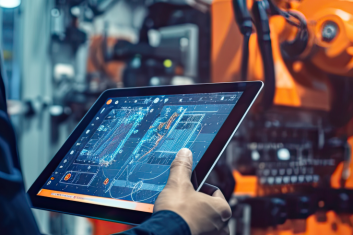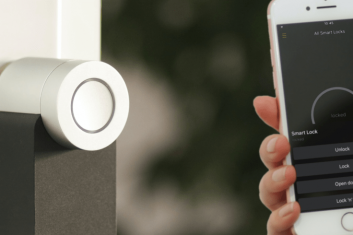To fully grasp the idea of IoT, we need to first figure out how it has been developing through time. We will skip all the “electricity invention” stage and build a more significant timeline. We will take a closer look at what IoT is and what it was to acquire a stronger understanding of its history.
In simple words, the Internet of Things is an environment of interconnected devices. It utilizes the Internet to share data and nearly any device you may now think of can be connected to it. The list of IoT technologies that support robust network performance includes diverse development frameworks, cloud-enabled platforms, numerous communication protocols that run on different hardware. These are cellphones, fitness wearables, motion sensors, cars and smart home appliances and more. But these are what we have in our present, the older IoT-like devices were different.
Need to develop an Internet of Things project?
We are ready to leverage our expertise to deliver a top-notch solution.
Anna Halias
Business Development Manager,
HQSoftware
The first landline of the telegraph was developed in the 1830-40s. It provided direct communication and inspired the further development of similar technologies.
The first wireless voice transmission was performed on June 3, 1900, over the radio, pushing the edge of innovation. This vital component of the future IoT environment was complemented by computers that appeared in the 1950s. Let’s build the timeline from this point, we have more to discover.
1982
The students of Carnegie Mellon University invent the ARPANET-connected coke machine. Four students from the School of Computer Science department installed the switches in the coke machine. They counted how many coke bottles had remained in each row and for how long. If the loaded bottle spends a long time in the machine, it is labeled “cold”. All this data was then remotely available to customers via a finger interface. This experiment had inspired a lot of inventors all over the world to create their own connected appliances.
1989
Tim Berners-Lee proposes the World Wide Web – the Internet as we know it. It had started as a packet switching network, growing and developing. In addition, a Global Positioning System becаme available for commercial use, the governmental system of satellites was complemented by the privately held ones, providing the future IoT systems with basic communications.
From this time inventors have had an opportunity to develop interconnected devices with ease. And the first examples were:
1990
At the annual exhibition organized by UBM, John Romkey introduces a toaster connected to the Internet. The toaster is considered to be the first IoT device. It was connected to the computer via a TCP/IP protocol.
1993
The XCoffee is created at the Computer Laboratory of the University of Cambridge. Two academics who worked at the Trojan Room in the laboratory had a video-frame grabber attached to one of the computers. They decided to connect a camera controlled by a server application that was observing the coffee pot and taking pictures of it several times a minute. Then the pictures were sent to the client application, to keep the user updated on the information about whether the pot was filled.
1994
“One of the first cameras on WWW”. Steve Mann creates a wearable Internet-connected camera. The WearCam was an “experiment in connectivity” – it was transitioning the captured images to the computer via the Internet.
1997
On October 13-14 the first International Symposium on Wearable Computers takes place. The Carnegie Mellon University, already known by its coke machine, MIT and Georgia Tech co-hosted this event to discuss the performance support of wearable computers, input mechanisms, communication capabilities, and more.
And to be done with the vital IoT components, we will take a look at the last one:
1998
The introduction of IPv6. This protocol had greatly increased the address space, being implemented in 2017. It had become a great addition to the IoT network that had already had more devices than the human population counted. Until 1998 it was hard to conceive of broad IoT networks because there were simply not enough IP addresses to register all the connected devices.
The next year was the most flourishing for technology, and we will pay more attention to it. One of the reasons is that eventually this year brought the “Internet of Things” term to life:
1999
Kevin Ashton introduces the term “Internet of Things”. Kevin, the Executive Director of Auto-ID Labs at MIT, had used this term in his presentation for Procter and Gamble, and now the whole world uses it. Back then the idea was sometimes called “embedded internet”, which did not describe it accurately. In this presentation, Kevin linked the ideas of RFID and the Internet, which greatly impressed the listeners because of its innovativeness.
Auto-ID Labs launches. Later this year Kevin Ashton, David Brock and Sanjay Sharma have carried out Kevin’s idea of the RFID connectivity. They have established Auto-ID Labs – a network of academic research laboratories, which objective is to develop new technologies and implement them in the commerce domain. As a result, they participated in the development of the RFID-based identification system – Electronic Product Code (EPC), that was intended to replace the barcodes. EPC can provide any object in the world with its own identification tag. EPC is a great example of the IoT’s ability to connect physical objects to a heterogeneous network with the help of sensors and other wireless means of communication.
People start to think about the future of IoT. Tech gurus, innovators, engineers, and influencers made predictions about the future driven by the all-new IoT technology. Neil Gross wrote in the Business Week journal: “… planet Earth will don an electronic skin. It will use the Internet as a scaffold to support and transmit its sensations. This skin is already being stitched together. It consists of millions of embedded electronic measuring devices: thermostats, pressure gauges, pollution detectors, cameras, microphones, glucose sensors, EKGs, electroencephalographs.” The 21 century seemed to bring the connected life to a new level, and that was exactly what happened.
2000
LG announces Internet Digital DIOS – world’s first Internet-enabled refrigerator. Yet the sales had not gone well, the refrigerator became a meme and now the history of IoT development is not full without it. The IoT-enabled refrigerator wasn’t warmly received by the consumer market, and the production was stopped – the price was considered too high. Later we will see these refrigerators again in a new light.
2004
The term “Internet of Things” becomes popular. Huge publishers, newspapers, and magazines started to mention IoT in their articles. For example, The Boston Globe has an archive of its publications where we can find the article “The Internet of things. Start-ups jump into next big thing: tiny networked chips” dated October 25, 2004. The article tells about a warehouse equipped with 600 wireless radio microchips. This was a successful IoT mesh network that was intended to replace wired controllers and provide space for future advanced applications, e.g. remote monitoring software. The high-tech future was predicted, with such networks being spread throughout other warehouses, homes, shops, and other places.
In addition to e-magazines, the term “Internet of Things” starts to appear in book titles.
RFID gains popularity. Walmart required its top 100 suppliers to place RFID tags to cases and pallets by 2005. Walmart wanted to replace the barcodes with RFID-based EPC codes and believed it would enhance the supply chain management. The suppliers were not happy with these requirements as EPC tags were costly and seemed to bring no benefits. Walmart, in turn, offered to provide the suppliers with Point of Sales information. As a result, Walmart had decreased its merchandise thefts and annual labor requirements. Now EPC is one of the global standards, connecting billions of “things” all over the world.
2005
Nabaztag appears. The Internet-connected device Nabaztag was a small robot for consumer use, manufactured to connect to WiFi networks, gather weather reports, news and stock market changes, and read them aloud to the owner. This rabbit-shaped ambient device showed the world how the Internet of Things can be gently embedded in everyday lives. Nabaztag was updated three times through its history, and in 2015 its servers and customer service were canceled due to the inability to advance technologically.
2008
The 1st International Conference on the Internet of Things (IoT 2008). The event was the first conference of its kind and took place in Zurich, Switzerland. It covered the topics of Internet of Things development, namely short-range wireless communications, real-time localization, sensor networks. Around 250 individual authors from 23 countries submitted their IoT review papers.
More “things” are connected to the Internet than people. Now this year is considered the time true IoT was born because of the connected devices boom. Already then there was a prediction that the IoT-enabled devices would outnumber the human population.
2009
Google starts testing self-driving cars. The first car to take an autonomous ride was a Toyota Prius. It had a sensor-enabled device on its upper deck that was able to detect pedestrians, cyclists, road work, and other valuable objects. Now the software is powerful enough to predict the behavior of all road users.
St. Jude Medical becomes an adopter of IoT for healthcare. It launched a Wireless USB Adaptor that received data from a patient’s cardiac implant and then securely transferred the data over cellular networks to physicians. When it was impossible to connect to a network, the device performed remote monitoring.
2010
China picks IoT as a key industry. Chinese premier Wen Jiabao wanted to tackle the financial crisis and other country-sensitive issues. He decided to pay extra attention to IoT after he had talked to the researcher who had been studying abroad. Wen considered the Internet of Things a perfect technology to implement across top strategic industries. The idea of the remote management and identification of different objects seemed perfect for the development of the country’s infrastructure and services. This was the first time IoT was recognized on a governmental level. Now China plans to earn $180 billion of potential market revenue by 2020.
Nest company starts to manufacture smart home appliances. Former Apple engineers joined for a startup that was born from the idea that thermostats were not meeting the requirements of the market. The first product was a Nest Learning Thermostat that was able to learn users’ habits and, as a result, optimize the heating schedule. This was the world’s first IoT thermostat powered with machine learning.
2011
World IPv6 Day. The event was organized by Facebook, Google, Yahoo, Akamai Technologies, and Limelight Networks. The main idea of the event was to motivate Internet providers, web hosting companies and similar across the industry to prepare for the transition from IPv4 to IPv6 when the IPv4 space runs out. More than 400 participants, including search engines, social and content distribution networks, joined the experiment.
Gartner adds IoT to the Hype Cycle. It tracked the lifecycle of technologies, and the IoT was immediately transitioning to the stage “peak of inflated expectations”. According to the graph, IoT would be able to reach the peak of the stage in 2014.
2013
Google announces a brand of smart glasses. Google Glass was a head-mounted device manufactured to fit the shape of eyeglasses. It featured a display that had the ability to show information hands-free, and a natural language voice recognition module to connect to the Internet via spoken commands. Yet the project was then closed until 2017, it is still a great example of “ubiquitous computing” and a futuristic IoT device.
The wide dissemination of connected devices available for consumers starts from the year 2014. The number of tech startups and technological corporations is consistently growing, feeding the market with more smart hardware and software. And recall the Gartner Hype Cycle – reading the following you will make sure that IoT did hit the top of the “peak of inflated expectations”.
2014
[emaillocker]
The number of mobile devices, wearables, and other gadgets exceeds the number of people. This year there were 7.2 billion devices, and the statistics showed that they were multiplying 5 times faster than humans.
Google reabsorbs Nest. Google spotted the potential behind the Internet of Things and smart home gadgets in particular and bought Nest to invest in the future of IoT-powered houses and complement its hardware division. Google didn’t change the brand identity of the Nest.
Google’s self-driving car is promised to hit real roads. The fully functional self-driving car was available for testing on public roads. Google was scrupulously examining different aspects of the car, paying the most attention to sensors and the software that brings everything together. The next year this prototype had performed an independent ride with a man inside – Steve took a successful ride on the roads of Austin, Texas.
Novartis partners up with Google to create contact lenses that measure glucose level. These lenses were supposed to look just like the regular ones, but have a slim microchip embedded. They were able to measure the level of glucose via a non-invasive method – analyzing the tears’ composition. Yet the lenses had the potential to lower the costs of chronic conditions management, they were not welcomed. Comparing to blood, tears were proved to be not suitable for glucose measurement. Novartis CEO Joe Jimenez hoped to see his revolutionary product on the market in 5 years, but the consumers were projected to access the novelty in 2020.
Tech giants hold a consortium to develop industrial IoT standards. Raising an issue of IIoT devices, processes, machines and humans interoperability, the following companies joined forces to improve IIoT integration: Intel, Cisco, IBM, GE, AT&T. The consortium is open for any company to join in order to shape the future of the Industrial Internet adoption. The participants get research reports, white papers, learn IIoT best practices and receive all the valuable information for the development of company-scale and global Industrial Internet.
Amazon releases an ambient device Echo. This was a cylinder-shaped smart speaker with voice control, capable of playing audiobooks, setting alarms, writing down the to-do lists, and other personal assistant tasks. The device achieved a certain success and now comes in a variety of shapes and technical parameters: Echo Dot, Amazon Tap and others. Unlike Nabaztag, Amazon Echo is being updated through time to meet the market requirements.
Samsung acquires a home automation startup SmartThing. Following the ideas of its predecessors, Samsung has made a great contribution to the market of IoT systems. Starting as a Kickstarter project, SmartThing now is a cornerstone of all Samsung smart projects. The startup produces hardware that can bind all pieces of one’s home IoT infrastructure together.
2015
Mattel produces IoT-enabled toys. Supporting the consumer IoT boom, Mattel produces a Barbie with an embedded WiFi module and a toy house with built-in interactive details: voice-controlled light bulbs and a toy oven with fire. After that, even kids could experience the world of connected devices.
The Global Standards Initiative on the Internet of Things takes place. The event’s key idea was to create a unified approach to the development of IoT technical standards, helping the technology to be adopted globally.
2016
General Motors invests in Lyft to create a network of self-driving cars. The automotive giant spent $500 million and announced a plan to create a ride-sharing service. Both sides of the partnership believed that self-driving cars will hit the market of ride-sharing first, rather than driver-owned vehicles. But, as we already know, the exact opposite has happened – Uber became extremely popular, unlike its rivals.
Cisco acquires Jasper. Another technical provider contributed to the development of global digitalization. Under the roof of Cisco, Jasper provided businesses with the ability to launch, manage and monetize their IoT services on a cloud-based platform. Jasper has also started a platform for connected cars, following the popular trend.
Apple showcases HomeKit products at Consumer Electronics Show. HomeKit is a proprietary platform that provides developers with comprehensive tools for developing smart home appliances’ software. Apple made it easier to create and manage IoT devices with Siri – wall outlets, light switches are easily controlled with voice.
Google releases Google Home. Yet another smart ambient device with an ability to heed the voice commands with the help of an intelligent Google Assistant. Google Home allows for integrating third-party services providing users with a wide field of interaction. The development of this device started with the intention to compete against Amazon Echo.
The first IoT malware appears. Mirai malware’s idea was extremely simple. The hardware manufacturers set default passwords for their devices, and sometimes the users forget to change them. Mirai collects the default credentials and hacks the devices that still have them. Then it uses the devices to perform DDoS attacks on popular websites. After the attack was successful and put down a number of websites for hours, the creator even opened the code of his virus for public use.
[/emaillocker]
2017
Large caps offer extended IoT service. A few examples:
- Microsoft launches Azure IoT edge that allows small devices to utilize cloud services even if they are not connected to the cloud.
- Amazon offers advanced security and device management features.
- Google releases Cloud IoT Core that allows devices to connect to the cloud more easily.
Judging from these facts, we can see that major technology leaders have realized that the Internet of Things requires a different set of tools and services for proper functioning, and as a result offer cloud platforms.
Governments around the world start to think about IoT security. Following a set of cybersecurity violations that have happened to different companies, the governments have started to consider developing the laws to make IoT environments safer. For example, Senator Mark Warner introduced the “Internet of Things Cybersecurity Improvement Act” to the US Senate. The act suggested to ban hard-coded passwords and deliver patches to devices, which was a low bar for IoT security.
Cryptocurrencies focus on IoT. The blockchain was linked to IoT because of the abovementioned security concerns. With the help of blockchain, devices can exchange smart contracts in a secure distributed environment. To help adopt blockchain and make IoT secure, a special organization “Trusted IoT Alliance” launched. And by the way, a number of cryptocurrencies were developed based on IoT: IoT Coin, IOTA, IoT Chain.
What else to come
Having all this information at hand, it is possible to foresee what is coming next in IoT.
- The IoT market value is expected to reach $8.9 trillion by 2020.
- The amount of IoT devices will reach 36 billion by 2021.
- The IoT security spending will reach $3.1 billion by 2021.
And, of course, the hackers will continue to use IoT devices to perform DDoS attacks. After the Mirai success hackers have the ability to get open-source viruses and botnets for own customization.
The AI is also considered the next big thing in IoT, along with an already popular blockchain that will further develop.
Briefly, let’s watch this intriguing domain to evolve and transform the way we live, and who knows what lies ahead.

HQSoftware Founder
Having founded the company in 2001, uses his broad knowledge to drive the company forward. Ready to share his wisdom on software development and technology insights
Related Posts
View All
We are open to seeing your business needs and determining the best solution. Complete this form, and receive a free personalized proposal from your dedicated manager.

Sergei Vardomatski
Founder







